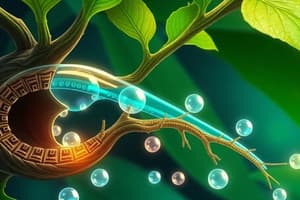Podcast
Questions and Answers
What is the primary function of xylem in plants?
What is the primary function of xylem in plants?
Transport of water and dissolved nutrients from the root system to the leaves and branches
Name two structures that make up xylem.
Name two structures that make up xylem.
Tracheids and vessel elements
Where does water uptake occur in the xylem?
Where does water uptake occur in the xylem?
Root hairs
How is the upward movement of water in xylem vessels made possible?
How is the upward movement of water in xylem vessels made possible?
What is the role of xylem in plant transport?
What is the role of xylem in plant transport?
What is the function of phloem in plants?
What is the function of phloem in plants?
Name two non-vascular tissues in plants.
Name two non-vascular tissues in plants.
What are some adaptations plants have evolved to meet their transport needs?
What are some adaptations plants have evolved to meet their transport needs?
What are some challenges plants face in transport?
What are some challenges plants face in transport?
Why is transport in plants vital for their overall health and survival?
Why is transport in plants vital for their overall health and survival?
Flashcards are hidden until you start studying
Study Notes
Transport in Plants: Understanding Xylem's Role
Transport in plants plays a vital role in the life cycle of these complex organisms, enabling the exchange of water, nutrients, and essential compounds between various parts of a plant. Today, we will delve into the topic of plant transport, focusing on xylem – one of the primary pathways involved in this process.
Xylem: The Vascular Tissue for Water and Nutrient Transport
Xylem is a specialized vascular tissue found in plants, which facilitates the transport of water and dissolved nutrients from the root system to the leaves and branches. Xylem's function is essential for maintaining the plant's overall health and survival.
Structure of Xylem
Xylem consists of long, tube-like structures called tracheids and vessel elements, which provide structural support and the transport channels. The tracheids and vessel elements are connected by pits, which allow water and nutrients to move efficiently between the adjacent cells.
Water Transport in Xylem
Water uptake occurs in the root hairs, where it is absorbed from the soil's moisture. The water then travels upwards through the xylem vessels in the root and stem, finally reaching the leaves. This upward movement of water against gravity is made possible by the cohesion and adhesion forces within the xylem.
Nutrient Transport in Xylem
Nutrients absorbed by the roots, such as potassium, calcium, and magnesium, are also transported through the xylem. The nutrients dissolve in water and travel alongside the water molecules. The xylem also plays a role in the transport of sugars derived from photosynthesis, such as sucrose and glucose.
Other Tissues Involved in Plant Transport
In addition to xylem, plants also have another vascular tissue called phloem. Phloem is responsible for transporting sugars and other organic compounds produced in the leaves to other parts of the plant, such as the roots and the developing fruits.
Apart from vascular tissues, plants also possess non-vascular tissues, such as parenchyma, collenchyma, and sclerenchyma. These tissues provide structural support, storage, and protection to the plant.
Adaptations and Challenges
Plants have evolved several strategies to adapt to their transport needs, such as:
- Root Transpiration: Some plants have specialized root systems that increase water uptake by facilitating a higher transpiration rate.
- Succulence: Succulent plants store water in their thickened stem or leaves, helping them survive during periods of drought.
- Water-use Efficiency: Some plants, like cacti, have evolved water-use efficiency strategies, such as specialized stomata or cuticle structures, to minimize water loss.
Plants also face challenges in transport, such as:
- Water Stress: Water scarcity caused by drought, high temperatures, and evaporation can hinder the plant's transport system, affecting growth and productivity.
- Nutrient Deficiency: Inadequate nutrient uptake and transport can cause nutrient deficiencies, leading to reduced growth and health issues.
In conclusion, transport in plants is vital for their overall health and survival. Xylem plays a significant role in water and nutrient transport, enabling the plant to maintain its various functions. Understanding plant transport and its adaptations will allow us to appreciate the intricate complexity of the plant kingdom and its role in maintaining life on earth.
Studying That Suits You
Use AI to generate personalized quizzes and flashcards to suit your learning preferences.





